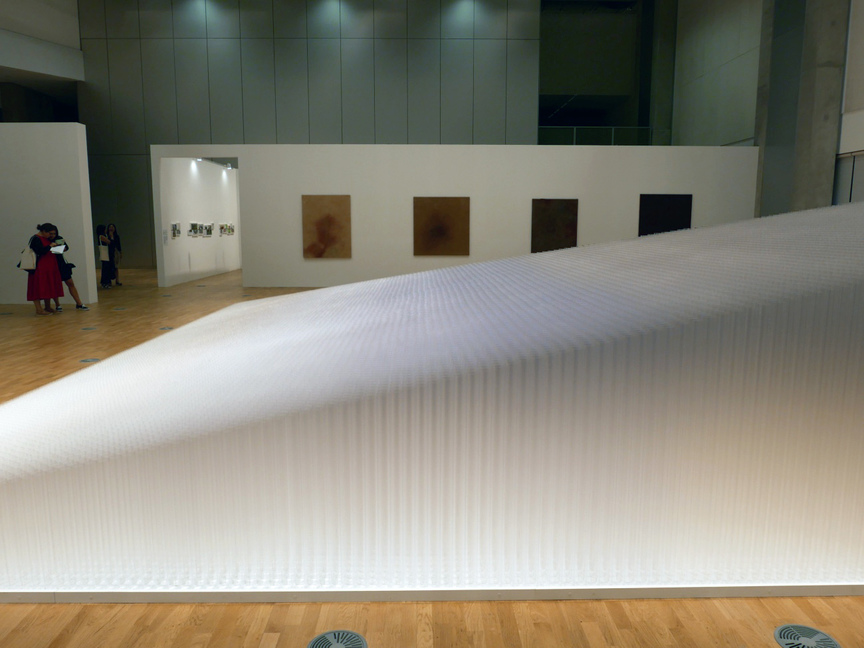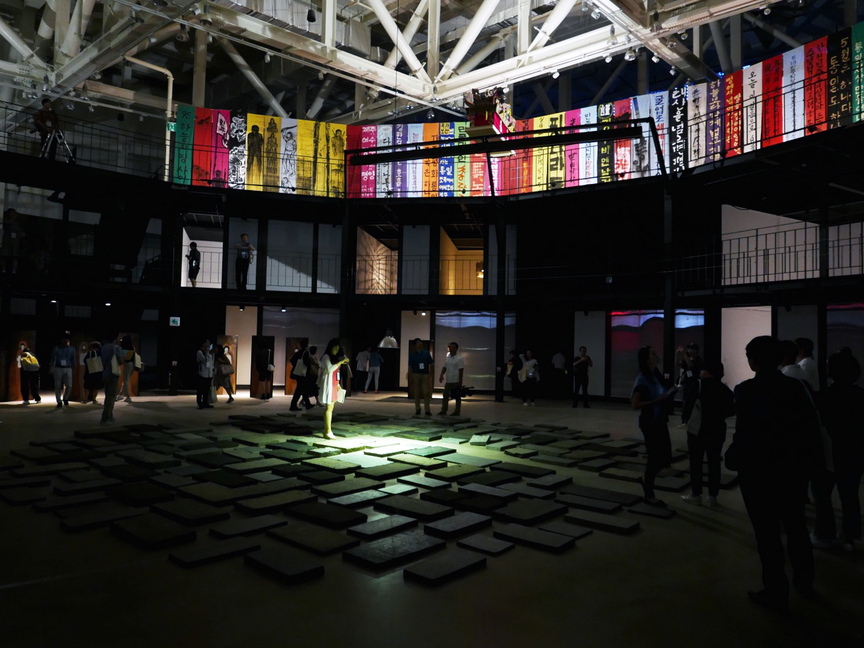
R
E
V N
E
X
T
The portions of Gwangju Biennale 2018 housed at the Asia Culture Center (ACC) and offsite venues were almost sizable enough to constitute another biennial. It was also at these locations that the endeavors of “Imagined Borders” became increasingly uneven in form and content. The biennial was still on solid footing at the ACC with the dramatic presentation of Adrián Villar Rojas’s two-channel film installation, War of the Stars (2018), one of the designated GB Commission works. Villar Rojas has been working toward the project since he first did a residency in 2014 in Yangji-ri, a village in the demilitarized zone (DMZ) near the boundary with North Korea, and created installations there. In subsequent years, he made a film, The Most Beautiful Moment of War (2017), which looked at life in the village populated entirely by the elderly. That film appears in War of the Stars along with footage of people watching films at the Gwangju Cinema, in a film-within-film-within-installation layering of what the artist calls “an eternal project.”
Up one set of escalators from Villar Rojas’s film in the ACC was the exhibition “Faultlines,” curated by Yeon Shim Chung and Yeewan Koon, which extended the theme of “Imagined Borders” by focusing on the often violent ruptures in individual and community identity when shared values are threatened or disregarded. Shilpa Gupta’s installation, Altered Inheritances – 100 (Last Name) Stories (2012–14), for instance, was a room of dozens of framed images cut horizontally and captioned with stories of individuals who changed their names for reasons including embarassment, personal aspirations, and fear of persecution. Byron Kim’s ongoing painting series “Synecdoche” (1991– ) comprises monochrome portraits of different individuals’ skin colors, while his “Bruise”paintings (2016) look like they are modeled on real-life injuries but are in fact made by boiling and dyeing the linen or canvas. The two series each reflect events and conversations about race happening in the United States. Historical wounds were the subject of Francis Alÿs’s video project The Silence of Ani, Turkish/Armenian Border (2015)—made for the 2015 Istanbul Biennial—featuring teenagers playing in the eponymous ruined ancient city and calling to the birds as if to enliven the atmosphere. Similarly, Yoshitomo Nara’s installation Tobiu (2018) involved the iconic draughtsman working with the few remaining elderly members of the titular community to illustrate local Ainu myths in drawings of children, as if bringing new life to the village. Of works that had been shown at the first Gwangju Biennale, John Pule’s distinctive paintings using Nuiean motifs, The Pulenoa Triptych and The Prototype: Site of Old Myths, along with Kcho’s sculpture of a rowboat resting on 2,000 beer bottles, Para Olvidar (all 1995), were inspired by colonial and modern traumas in the Pacific and Caribbean, respectively. Though they were both included in “Faultlines”—and here’s where things became meta-layered in the exhibition—they were also part of curator David Teh’s “Returns,” about revisiting the festival’s history and the mid-1990s Asian art context—a project that was primarily housed back on the lowest level of the Gwangju Biennale Exhibition Hall. The artworks paired nicely with one another and seamlessly into the exhibition. In fact, Kcho’s boat, echoing the Cuban exodus to the US on rafts in 1994, could have even been part of the section curated by Gridthiya Gaweewong, “Facing Phantom Borders,” also at the Gwangju Biennale Exhibition Hall, next to, say, Tiffany Chung’s paintings and archives about Vietnamese refugees. More integration of Teh’s “Returns” project throughout the biennial could have strengthened the 2018 edition’s connection to the legacy of 1995.
The plot of “Faultlines” got a bit shaky by the end, and many people missed the massive three-channel video installation by Aernout Mik, Double Bind (2018), featuring three performers wearing French anti-terrorism outfits writhing around (in my limited viewing of it), and two other photographic projects by Seung Woo Back and Joonho Yum, both about the Gwangju Military Hospital, which was located in the modernist Jeollanam-do Provincial Government office, located just atop the massive steel canyon that is the ACC complex. The Biennale’s size was its weakness.
The Biennale’s least convincing section was “The Art of Survival: Assembly, Sustainability, Shift,” which had three male curators (Man Seok Kim, Sung woo Kim, Chong-Ok Paek), and three more sub-themes (“Symmetrical Imagination,” “Momentum Temporary,” and “Assembly Place and Non-Place”) that were supposedly linked “through the lens of techne” and energy—concepts that would seem to connect any and all kinds of artwork. It’s still not really clear to me, even re-reading the materials again, what place these three showcases—with a total of roughly 30 Korean artists—had in relation to the biennale’s theme or why they were necessary, though there were a few interesting works interspersed from Teh’s “Returns” project. One of them was Yeonkun Kang’s 1995 installation of painted funereal streamers, Between Heaven and Land, made for an anti-biennale event staged by artists of Minjung and other movements called the Gwangju Unification Art Festival. Another of the “Returns” was Lee Ungno’s famous “Group of People” paintings, also presented at the 1995 edition, which connected with Woosung Lee’s contemporary large-scale cityscape Floating Lights on the Street (2016) in another section. I was happy to see more of Suki Seokyeong Kang’s installations with wooden frames and hand-dyed mats, as well as the three-channel video Black Mat Oriole (2016–17), an evolution of her installation shown at the 2016 Gwangju Biennale.
The particular mental fatigue that comes from curatorial incoherence was lifted by the very powerful presentation of North Korean chosonhwa (ink wash) paintings in “North Korean Art: Paradoxical Realism,” curated by scholar BG Muhn. Divided into four sections—ideological, landscape, literati and animal painting—the selected works were much more beautiful in their execution and subtlety than the subjects usually portrayed, such as “the joy of smelting,” dam construction or historical battles—although a street scene by Kim In Sok, Rain Shower at the Bus Stop (2018) could have been a depiction of any East Asian city mid-deluge. The landscape and animal paintings were similarly mesmerizing in their technical prowess and sense of human awe for the natural world, completely shattering any preconceptions of art from North Korea being just propaganda posters, or of the artists as purely agents of the regime.
Beyond the many exhibitions were performances, talks and symposia that happened at times spread by word of mouth, often just after they had already begun. There were also supposed to be other major works: at the derelict, former Armed Forces Gwangju Hospital—the site where many of the wounded from the Uprising were taken, and which later became a mental hospital—were commissioned works by Kader Attia, Mike Nelson and Apichatpong Weerasethakul. They were all disappointments. Apichatpong’s installation wasn’t working at all during the opening days. Mike Nelson’s piece in an abandoned church near the hospital was made from hanging mirrors taken from the hospital, but even at 5pm (the venue was only open 3–6pm), the space was almost too dark for any kind of light to be reflected, and there were too many people for it to be a solemn experience, despite the weighty potential of these mirrors about the acts people had witnessed in them. The same applied to Kader Attia’s installation of wooden totem-like poles in a wing of the building last used as a psych ward. They were somber markers and evoked the presence of people who had inhabited these spaces but somehow were no match for the ghosts of the place itself.
There was even more: the Pavilion Projects organized by the Helsinki International Artist Program, Palais de Tokyo and Philippine Contemporary Art Network had their own premises and their exhibitions did feature notable artworks. Yet like many of the Biennale’s projects, they were eclipsed among the many parts of a festival with ambitions expanding in seemingly all directions at once, making it well beyond the capacity of a single viewer to absorb in two days.
This is part two of the blog. To read part one, click here.
HG Masters is ArtAsiaPacific’s editor-at-large.
The 12th Gwangju Biennale runs to November 11, 2018.
To read more of ArtAsiaPacific’s articles, visit our Digital Library.







